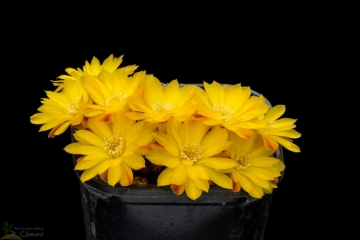Accepted Scientific Name: Rebutia cardenasiana (R.Vásquez) G.Navarro
Lazaroa 17: 76 1996

HS 41(Collector Heinz Swoboda) Peña Calorado to Pasorapa km 36.5, Chuquisaca, Bolivia, 2300m.
HS 41Peña Calorado to Pasorapa km 36.5, Chuquisaca, Bolivia, 2300m.
Origin and Habitat: Rebutia cardenasianaSN|31362]]SN|31362]] is endemic to Cochabamba and Chuquisaca, Bolivia. The species is present in a large area, however it is unknown how abundant it is, there might be some decline in the population however, is difficult to establish how significant this is.
Altitude range: Rebutia cardenasianaSN|31362]]SN|31362]] grows at at elevations of 1,800-2,800 metres above sea level.
Habitat and Ecology: This species grows in seasonally dry inter-Andean valleys on sandstone outcrops. Part of the species range is affected by agriculture.
Synonyms:
See all synonyms of Rebutia cardenasiana
back
Accepted name in llifle Database:Rebutia cardenasiana (R.Vásquez) G.NavarroLazaroa 17: 76 1996Synonymy: 6
back
Description: Rebutia cardenasianaSN|5221]]SN|31362]] (firstly described as SulcoSN'> 31363' alt='31362'>Rebutia cardenasiana#SN#31362'>Sulco[[Rebutia cardenasianaSN' style='border:none;'> by R. Vásquez in 1975) is a beautiful yellow-flowered Sulco from Bolivia. It is a cute globular cactus with short pectinate spines related to Rebutia steinbachiiSN|31362]]SN|5221]], but sufficiently differentiated and considered a good species on its own.
31363' alt='31362'>Rebutia cardenasiana#SN#31362'>Sulco[[Rebutia cardenasianaSN' style='border:none;'> by R. Vásquez in 1975) is a beautiful yellow-flowered Sulco from Bolivia. It is a cute globular cactus with short pectinate spines related to Rebutia steinbachiiSN|31362]]SN|5221]], but sufficiently differentiated and considered a good species on its own.
Stems. Solitary, globose, dark green, to 5 cm high and 8 cm in diameter.
Ribs: 14, spiraling, tuberculate.
Areoles: Yellowish white.
Central spine: One, often absent.
Radial spines: Pectinate, white, yellowish or brownish 5-10 mm long.
Flowers: Yellow (rarely orange or white), 2.5 cm long and in diameter.
Fruits: Globose, green.
Subspecies, varieties, forms and cultivars of plants belonging to the Rebutia cardenasiana group
 Rebutia cardenasiana (R.Vásquez) G.Navarro: has tiny globular stems with short pectinate white, yellowish or brownish spines. Flowers are yellow. Distribution: Cochabamba, Bolivia.
Rebutia cardenasiana (R.Vásquez) G.Navarro: has tiny globular stems with short pectinate white, yellowish or brownish spines. Flowers are yellow. Distribution: Cochabamba, Bolivia. Sulcorebutia langeri K.Augustin & Hentzschel: has pectinate white spines covering the black-green stems and produces sunny yellow flowers. North of Vallegrande, Santa Cruz, Bolivia.
Sulcorebutia langeri K.Augustin & Hentzschel: has pectinate white spines covering the black-green stems and produces sunny yellow flowers. North of Vallegrande, Santa Cruz, Bolivia. Sulcorebutia langeri G245/5 km 10, Valle Grande to Mataral, Santa Cruz, Bolivia: has pure white spines and nice white flowers instead of yellow. Distribution: km 10, Valle Grande to Mataral, Santa Cruz, Bolivia
Sulcorebutia langeri G245/5 km 10, Valle Grande to Mataral, Santa Cruz, Bolivia: has pure white spines and nice white flowers instead of yellow. Distribution: km 10, Valle Grande to Mataral, Santa Cruz, Bolivia
Bibliography: Major references and further lectures
1) Lowry, M. 2013. Rebutia cardenasiana. The IUCN Red List of Threatened Species. Version 2015.2. <www.iucnredlist.org>. Downloaded on 25 July 2015.
2) James Cullen, Sabina G. Knees, H. Suzanne Cubey “The European Garden Flora Flowering Plants: A Manual for the Identification of Plants Cultivated in Europe, Both Out-of-Doors and Under Glass” Cambridge University Press, 11/Aug./2011
3) David Hunt, Nigel Taylor “The New Cactus Lexicon” DH Books, 2006
4) Edward F. Anderson “The Cactus Family” Timber Press, 2001
5) John Pilbeam “Sulcorebutia and Weingartia: A Collector's Guide” Timber Press, 1985
 Sulcorebutia cardenasiana (Rebutia cardenasiana) Photo by: Peiffer Clement
Sulcorebutia cardenasiana (Rebutia cardenasiana) Photo by: Peiffer ClementSend a photo of this plant.The gallery now contains thousands of pictures, however it is possible to do even more. We are, of course, seeking photos of species not yet shown in the gallery but not only that, we are also looking for better pictures than those already present.
Read More... Cultivation and Propagation: This species loves a very permeable, coarse mineral soil as well as to be strictly kept dry throughout the winter quiescent period since it is very sensitive to any moisture excesses. To prevent rottenness it is also advisable to surround its root neck by very rough sand or grit, this help a fast water drainage and an appropriate air circulation. Plants are quite frost hardy -5 (-10)° C.
Watering Needs: Water moderately in the growing season, keep dry during the winter rest
Frost Tolerance: Overwinter in a cool place (at 0/10°C) this is important for the flowers as well as for plants health. Without this cool winter period they normally wont get any buds.
Sun Exposure: Needs a full sun exposure (light shadow my be useful in the hottest summer days)
Propagation: Seed, cutting, grafting.











